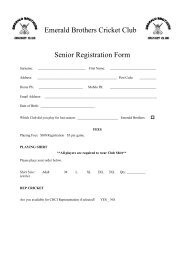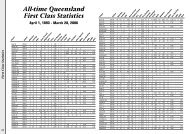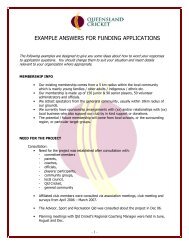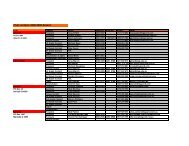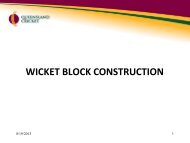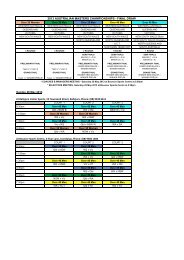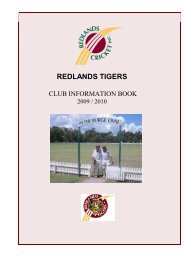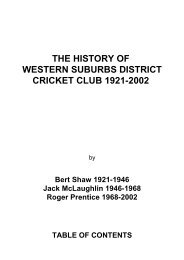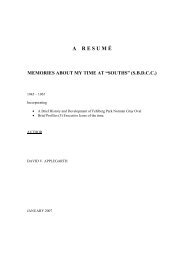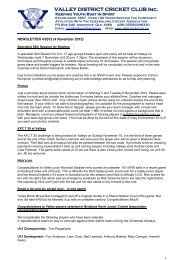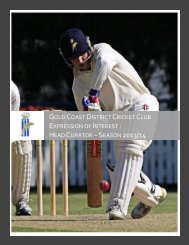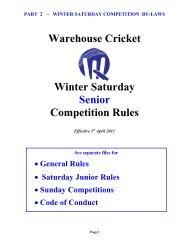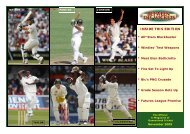2012 - 2013 PREMIER GR ADE HANDBOOK - Queensland Cricket
2012 - 2013 PREMIER GR ADE HANDBOOK - Queensland Cricket
2012 - 2013 PREMIER GR ADE HANDBOOK - Queensland Cricket
Create successful ePaper yourself
Turn your PDF publications into a flip-book with our unique Google optimized e-Paper software.
[g] If found guilty of a Level 1 offence, a player would ordinarily expect to receive a minimum one [1] multi-day<br />
match suspension [or equivalent]. If found guilty of a Level 2 offence, a player would ordinarily expect to<br />
receive a minimum two [2] multi-day match suspension [or equivalent].<br />
[h] The Conducts Commissioner may vary the level of offence [higher or lower]<br />
[i] A breach of the Code of Behaviour will be graded and the penalty determined within the three [3] levels as<br />
outlined.<br />
[j] For level 2 or level 3 offences, the Commissioner or Conducts Committee has discretion to determine whether a<br />
suspension applies for representative matches<br />
[k] The findings of the Conducts Commissioner or Conducts Committee should clearly define the time frame of the<br />
suspension, be it for one day match[es], two day match[es] or a time frame.<br />
[l] Each of the rules for behaviour has a guideline. The guidelines are intended as an illustrative guide only and in<br />
the case of any doubt as to the interpretation of the Rule, the provisions of the Rule itself shall take precedence<br />
over the provisions of the guidelines. The guidelines should not be read as an exhaustive list of offences or<br />
prohibited conduct.<br />
GUIDELINE OFFENCES<br />
1. Level 1 Offences<br />
The Offences set out at 1.1 to 1.6 below are Level 1 Offences. Players and, where applicable, officials must not:<br />
1.1 Abuse cricket equipment or clothing, ground equipment or fixtures and fittings<br />
Includes actions outside the course of normal cricket actions such as hitting or kicking the wickets and actions<br />
which intentionally or negligently result in damage to the advertising boards, boundary fences, dressing room<br />
doors, mirrors, windows and other fixtures and fittings.<br />
1.2 Show dissent at an umpire’s decision by action or verbal abuse<br />
Includes excessive, obvious disappointment with an umpire’s decision or with an umpire making the decision<br />
and obvious delay in resuming play or leaving the wicket.<br />
This Rule does not prohibit the bowler involved in the decision or a team captain from asking an umpire to<br />
provide an explanation for a decision or a Team official from making a formal complaint.<br />
1.3 Use language that is obscene, offensive or insulting and/or the making of an obscene gesture<br />
This includes swearing and offensive gestures which are not directed at another person such as swearing in<br />
frustration at one’s own poor play or fortune.<br />
This offence is not intended to penalise trivial behaviour. The extent to which such behaviour is likely to give<br />
offence shall be taken into account when assessing the seriousness of the breach.<br />
1.4 Engage in excessive appealing<br />
Excessive shall mean repeated appealing when the bowler/fielder knows the batsman is not out with the<br />
intention of placing the umpire under pressure. It is not intended to prevent loud or enthusiastic appealing.<br />
However, the practice of celebrating or assuming a dismissal before the decision has been given may also come<br />
within this Rule.<br />
1.5 Point or gesture towards the pavilion in an aggressive manner upon the dismissal of a batsman<br />
Self explanatory.<br />
1.6 Breach any regulation regarding approved clothing or equipment<br />
This includes regulations regarding bat logos and regulations regarding other logos or advertising which may be<br />
worn or displayed.<br />
2. Level 2 Offences<br />
The Offences set out at 2.1 to 2.9 below are Level 2 Offences. Players and, where applicable, officials must not:<br />
2.1 Show serious dissent at an umpire’s decision by action or verbal abuse<br />
Dissent should be classified as serious where the dissent is expressed by a specific action such as the shaking of<br />
the head, snatching cap from umpire, pointing at pad or inside edge, other displays of anger or abusive language<br />
directed at the umpire or excessive delay in resuming play or leaving the wicket.<br />
112



